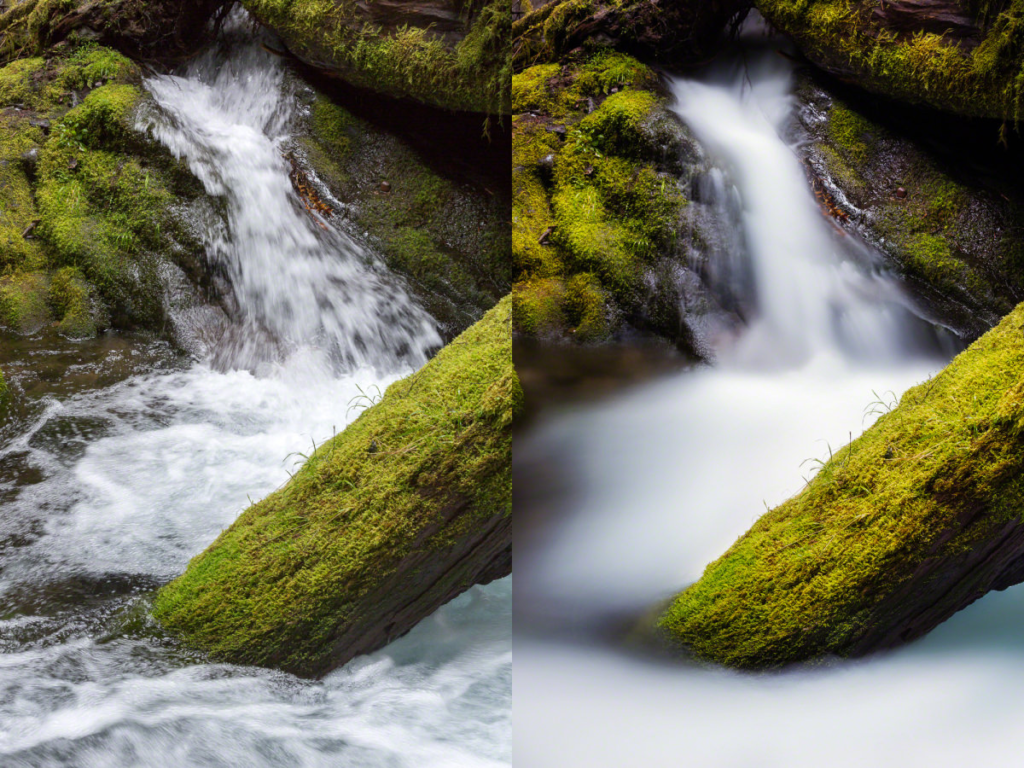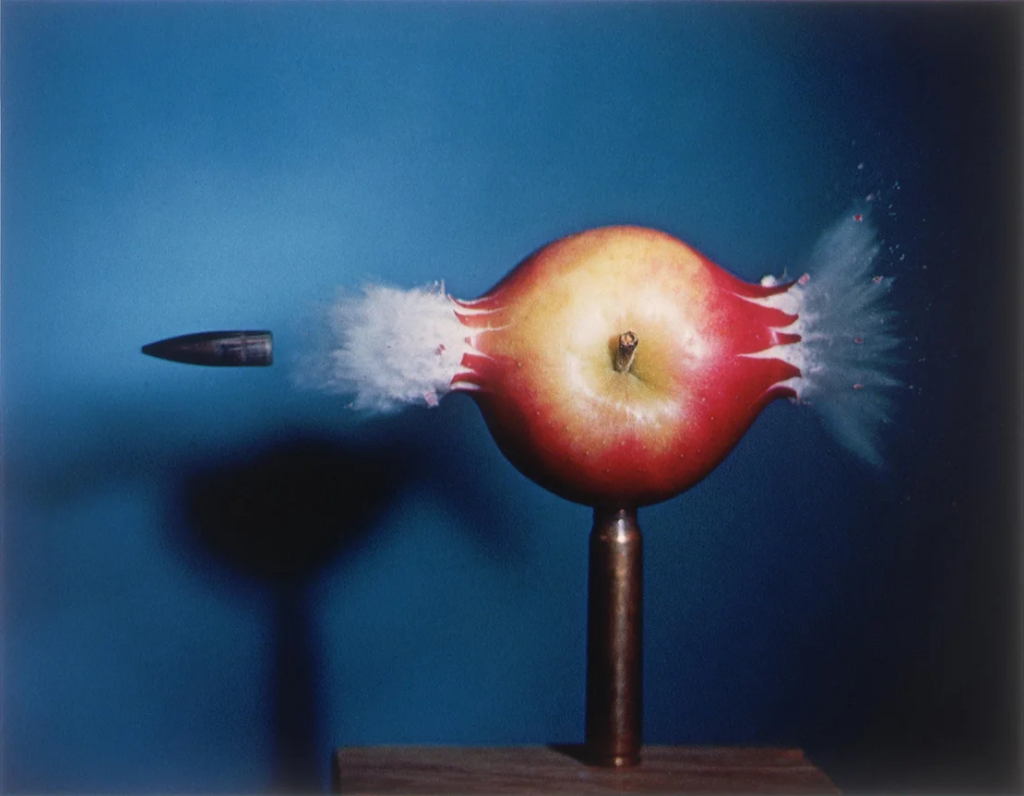shutter speed – the speed at which the shutter of the camera closes. A fast shutter speed creates a shorter exposure — the amount of light the camera takes in —while a slow shutter speed gives the photographer a longer exposure.
Low shutter speeds are used for scenarios where the lighting in the area is low, This is because the camera needs more time to capture the light so that the photo is not too dark or unreadable due to the lack of exposure. As shown in the diagram below, the camera needs more time to properly adjust to the light in the scene in order to avoid over exposure as seen in the photo taken at a shutter speed of 1/2.

On the other hand, Higher shutter speeds are excellent at freezing and capturing fast paced moments which are usually impossible to see just through the use of eyes, for example, attempting to capture water droplets in movement or a car mid f1 race.
A fast shutter speed, say, in the 1/500th second range, will freeze the water and give it a gnarly, crunchy look. A long, multi-second shutter speed will make waterfalls look silky and veil-like. Both looks can work, but what looks best will depend on the subject and your personal preferences as a photographer.

The general rule for the shutter speed when it comes to astrophotography is to go with anything between 10 and 30 seconds depending on your focal length. The longer the shutter speed you use, the lower the ISO you can use but using a shutter speed too long can result in blurry stars due to the Earth’s rotation.

Slow shutter speeds and long exposures enable you to create motion blur in your photos. Again, the speed of the moving object will determine how slow the shutter speed needs to be.

Photographers known for shutter speed.
Eadweard Muybridge
is celebrated for his ground-breaking studies of motion, which laid the groundwork for the development of cinema. He was commissioned to capture a horse’s movement to demonstrate that its hooves are off the ground during a trot.
Between 1878 and 1886, Muybridge conducted pioneering chrono photography of animal locomotion, employing multiple cameras to capture various positions within a stride. He also invented the zoopraxiscope, a device that projected painted motion pictures from glass discs, predating the use of flexible perforated film strips in cinematography.

Harold Edgerton
Harold Edgerton was an American electrical engineer and photographer known for his pioneering work in high-speed photography. He developed techniques and equipment that allowed for the capture of fast-moving subjects, revealing details that the human eye could not see.
His iconic images include a bullet piercing an apple and the moment a drop of milk splashes into a pool, showcasing the beauty and complexity of motion. Edgerton’s innovations in strobe lighting and high-speed cameras not only advanced photography but also contributed to scientific research in fields like physics and biology, making him a significant figure in both art and science.

Hiroshi Sugimoto
Hiroshi Sugimoto is a Japanese photographer known for his striking and contemplative works that explore themes of time, memory, and the nature of reality. His most famous series include “Theaters,” featuring long-exposure images of classic movie houses, and “Seascapes,” capturing the tranquil beauty of oceans across different locations and times.
Sugimoto’s use of long exposure creates a sense of timelessness, blurring the lines between the past and present. His work often invites viewers to reflect on the passage of time and the relationship between the observer and the observed, making him a significant figure in contemporary photography.

Francesca Woodman
Francesca Woodman was a groundbreaking photographer known for her evocative and surreal images, many of which were taken at her family’s farmhouse near Florence, Italy. Her upbringing in a culturally rich environment deeply influenced her artistic development, drawing inspiration from surrealist artists like Man Ray and Claude Cahun.
Woodman honed her skills at the Rhode Island School of Design, where she began to explore complex themes of identity and the human experience. In the 1970s, a time when photography was often undervalued compared to painting and sculpture, her innovative approach helped elevate the medium. Woodman’s work paved the way for future American photographers, such as Cindy Sherman and Nan Goldin, who similarly examined identity and self-representation in their art.

Here’s a quick summary of shutter speed guidelines:
- Shutter Speed Rule: As a general rule, your shutter speed should be double (or more) the focal length of your lens. For instance, with a 50mm lens, aim for at least 1/100th of a second, and for a 75mm lens, at least 1/150th of a second.
- Slow Shutter Speed: A slow shutter speed keeps the shutter open longer, allowing more light to hit the sensor. This can lead to motion blur for moving objects and is useful for low-light situations or when you want to capture the sense of movement in a scene.
Shutter Speed Shoot
The focus of this shoot was to experiment with different shutter speed and how it effects movement.

I begun the selection process with 100 pictures, in order to compress this less photos I will use the PnX process to select which photos I want to keep and which I want to discard.

Using the PnX process, I cut down to 24 photos, now I will repeat this process and pick out the best couple photos which I will present.

Here I am using the X/Y feature to compare the two images, once I am satisfied with one I will simply press X on one of them to discard them of the view.


Final set of images which I will use on the blog, the star system also allowed me to decide between images which I prefer and which ones I dislike.
Final Pieces.


Using a fast shutter speed ( 1/125) , I captured the red ball in mid-air, suspended between the trees, creating a striking contrast against the natural backdrop. The high shutter speed froze the motion perfectly, allowing the ball to appear crisp and sharp, avoiding any motion blur and emphasizing the vibrant red against the greenery.


In this image, the use of a 4-second shutter speed creates an ethereal, ghostly effect, capturing multiple overlapping exposures of my model ( Alfie) as he shifts slightly during the long exposure. The soft blur adds a sense of motion, almost as if the subject is moving through time, creating a surreal, dreamlike quality. The background, filled with books and papers, remains relatively sharp, while the subject’s face is duplicated thrice across the frame, producing a unique layering effect that conveys both motion and stillness. The dim lighting enhances the mood, giving the image a mysterious and slightly abstract feeling.

I used a long exposure to capture the subject as they spun around, creating a dramatic, distorted effect. The 4-second shutter speed allowed for the body to blur and stretch across the frame, making the subject appear as though they’re being pulled in multiple directions. The spinning motion produced a swirling effect where limbs and the head melt into each other, resulting in a fluid, abstract form. The contrast between the still background and the distorted body creates a surreal, dreamlike quality, emphasizing the movement in an almost otherworldly manner.


In this attempt, I aimed to capture a subtle motion by having the subject move only their head during the long exposure. However, the experiment didn’t go as planned—the subject moved their head too rapidly and inconsistently, causing the entire head to blur into an almost ghostly smear. Instead of a distinct motion trail or soft blur, the head nearly vanished from the frame, creating a strange, disjointed image where the body remains sharply in focus but the head has become a faint, formless blur. This unintended effect results in a surreal, eerie composition where the absence of a clear head makes the subject appear almost headless, adding an unintentional element of distortion and mystery to the photograph.

In this shot, I used a long shutter speed combined with cold lighting, but unlike previous attempts, there was no movement from the subject. By staying perfectly still throughout the exposure, the subject remains sharp and clear, with no motion trails or blurring. The cool-toned lighting adds a stark, almost clinical atmosphere to the image. The long exposure doesn’t introduce any distortion or ghostly effects—instead, it enhances the stillness. The focus is sharp across the entire frame, capturing every texture and detail in both the subject and the surroundings, resulting in a crisp photograph. The

In this image, the fast shutter speed perfectly captures three tennis balls suspended in mid-air, seemingly frozen against the plain background of the sky. The high shutter speed ensures there is no motion blur, allowing the balls to appear sharp and crisp as if they are floating in a straight, horizontal line. The simple, cloudy sky creates a minimalistic backdrop, drawing all attention to the alignment of the tennis balls, emphasizing their identical positions and uniform spacing. The fast shutter speed essentially freezes time, giving the impression that the balls are defying gravity, creating a balanced and clean composition that plays with movement and precision.